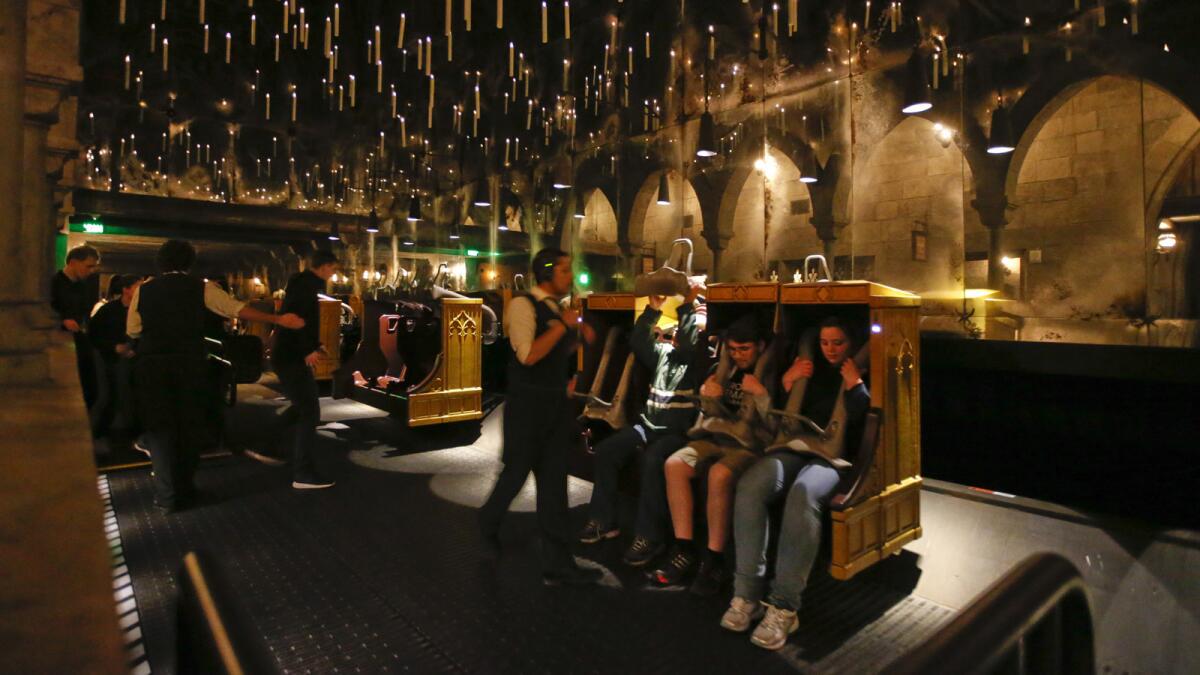How big is too big? Some theme park riders fear small seats and ‘the walk of shame’

Universal’s Harry Potter and the Forbidden Journey has bedeviled many big and tall riders who discover at the last moment that their journey aboard the new attraction is indeed forbidden because they don’t fit in the “enchanted benches.”
The uncomfortable scene is a familiar one to anybody who has ever visited a theme park: The overweight rider becomes increasingly embarrassed as the ride attendant pushes and shoves with all his might on the over-the-shoulder restraint that stubbornly refuses to click closed. Everybody waiting in line knows what comes next: the walk of shame.
“The walk of shame is an embarrassing experience,” said Mike Galvan, who penned the “Big Boy’s Guide to Roller Coasters.” “I’ve been there many times. It’s disheartening.”
Galvan likens the straight back and flat seat on Forbidden Journey to an “old wooden chair” that provides little wiggle room for larger riders.
“When the over-the-shoulder restraint comes down, if part of you is hanging over, whether it be your gut, your thighs or your shoulders, you’re going to be very uncomfortable,” Galvan said.
While there are no height or weight maximums for Forbidden Journey, the safety restraints must be able to close properly in order for guests to ride, Universal officials said.
Like many theme park attractions, Forbidden Journey has a tester seat near the entrance for visitors who might be worried they won’t fit on the ride. But as big and tall riders will tell you, those tester seats often can be misleading.
“I do not trust the accuracy of the test seats, no matter the park,” Galvan said. “I can only suspect that the seat belts on the test seats are intentionally short to minimize the potential of riders getting the ‘walk of shame’ at the station. I’ve also had the opposite happen, where I made the test seats but was rejected from the actual ride.”
Galvan, 31, is a regular contributor to SFGAmWorld, a fan site for Six Flags Great America outside Chicago. In 2007, he was so overweight that he stopped going to theme parks because he no longer could fit on the rides. Over the next three years, he lost more than 130 pounds so he could return to his passion: roller coasters.
Anybody who has ever been kicked off a ride because he or she was too big will tell you that theme park attractions are not designed for people who are heavier or taller than average.
All theme parks have euphemistic names for “exceptional sized riders” or “guests of larger size” —those who are too fat or too tall to fit safely in an attraction seat. Some ridemakers even try to make accommodations with “big boy seats.”
So how big is too big?
Cedar Fair, the parent company of Knott’s Berry Farm and 10 other amusement parks, offers very specific size requirements for “guests of larger size.” Cedar Fair warns that men over 6 foot 2 inches or 225 pounds with a 40-inch waistline or 52-inch chest “may not be accommodated on some of our rides.” The park operator says women over 200 pounds who wear a size 18 or larger could have trouble fitting on some rides.
At Ohio’s Cedar Point, some coasters like Millennium Force, Top Thrill Dragster and GateKeeper have a 6-foot-6-inch height maximum. Ohio’s Kings Island institutes height maximums for a number of rides, including Firehawk (6-foot-9), Invertigo (6-foot-6) and Delirium (6-foot-4). Tennessee’s Dollywood has 6-foot-6-inch height maximums on a number of rides, including the Wild Eagle wing coaster. The Green Lantern: First Flight at Six Flags Magic Mountain has a height maximum of 6 foot 5 inches.
Busch Gardens Williamsburg in Virginia sets aside two rows of seats on the Alpengeist and Griffon coasters for riders with “chest measurements exceeding 52 inches.”
Utah’s S&S Worldwide, which makes roller coasters and drop towers, sets its restraints for a maximum weight of 300 pounds and equips its seatbelt locking mechanisms with no-go sensors that restrict over-sized riders.
Splashin’ Safari water park at Holiday World in Indiana uses a walk-on scale to ensure the maximum weight on the six-passenger Mammoth rafts doesn’t exceed 1,050 pounds.
Disney parks have no height or weight maximums on any attractions, according to officials. Disneyland famously replaced the 1964 boats on It’s a Small World because the increasing waistlines of Americans were causing them to run aground — an assertion reported by MiceChat and vigorously denied by Disney officials.
Theme park officials typically respond with prepared statements when asked about making accommodations for “riders with unique physical attributes” (such as this one from Six Flags): “We work closely with ride manufacturers to incorporate safety systems that are designed to accommodate people of average physical stature and body proportions. We require that all seatbelts, lap bars and shoulder harnesses be positioned and fastened properly. Due to the rider restraint system, guests of a larger size may not be accommodated on some rides.”
As has been well documented, Americans are getting fatter. The average weight for adult men has risen from 166 pounds in 1960 to 195 pounds in 2012, according to the Centers for Disease Control and Prevention. The average weight for women increased from 140 to 166 pounds during the same period.
Addressing the issue is complicated for ridemakers in part because every rider carries weight differently — with problem areas ranging from the hips, waist and stomach to the chest and shoulders. For big riders, coaster rideability varies from park to park.
One of the biggest concerns for larger riders is what Galvan calls the “seat belt lottery.”
“It’s absolutely amazing how from one row to another, the length of the seat belt will vary,” Galvan said. “The only reason I can think for this irregularity would be off-season maintenance. Some rides are more egregious than others in this department.”
Older coasters by Arrow Dynamics and Schwarzkopf tend to be the easiest to ride for larger riders, according to Galvan’s “Big Boy’s Guide to Roller Coasters.” Some Bolliger & Mabillard rides can be tight fits, while others offer rows with larger seats, Galvan said. Vekoma, Gerstlauer and Mack Rides typically present few problems, while Premier and Intamin often prove difficult for bigger riders, he said. Intamin’s suspended launch coasters like Wicked Twister at Cedar Point and Volcano at Virginia’s Kings Dominion cause the most problems for big riders, Galvan said.
“The issue with these rides is the seat belt and the lack of an audible ‘click’ when pulling the restraint down,” Galvan said. “Not to mention that you have the seat several feet off the ground, so you have to tippy toe or jump up to get into the seat. Depending on your body dimensions, you might not be able to maneuver yourself to get into the seat properly.”
There are no industry standards among ridemakers and amusement parks when it comes to accommodating bigger riders. Some parks require two locking clicks to secure a lap bar or over-the-shoulder restraint on a ride, while others insist on three clicks. Seat belt lengths can vary from ride to ride and row to row.
“Most manufacturers, if not all, hoping to do business in the U.S. are now offering optional ‘jumbo’ seats to buyers to fit larger adults,” said Bob Dean of Florida-based Leisure Labs, which represents Mack Rides, Great Coasters International and Mondial.
Parks cite safety concerns whenever a large rider is prohibited from a ride. In recent years, there have been several high-profile accidents involving larger riders being thrown from a theme park ride.
A man who weighed more than 300 pounds was seriously injured in 1999 when he was ejected from the Superman coaster at the former Six Flags Darien Lake. Six Flags argued that the man was too large for the ride’s lap bar restraint to engage.
Investigators said the rider’s weight was a contributing factor in the death of a 292-pound woman who fell out of the Perilous Plunge water ride at Knott’s Berry Farm in 2001.
In 2004, a 5-foot-2-inch, 230-pound man fell to his death from the Superman roller coaster at Six Flags New England. A state report found the overweight man’s girth prevented a T-bar restraint from fitting firmly.
MORE
32 best new theme park additions of 2016
8 unanswered questions about Disneyland’s Star Wars Land
Disneyland 2055: What the future may hold for the original Disney park
Hey, Harry Potter fans, here’s an exclusive sneak peek at Universal’s Wizarding World
Everything you need to know about Shanghai Disneyland
21 creepiest abandoned amusement parks
> Sign-up for our weekly In the Loop theme park newsletter
> Follow the Los Angeles Times Funland theme park blog on Twitter, Facebook, Google+ and Instagram
Sign up for The Wild
We’ll help you find the best places to hike, bike and run, as well as the perfect silent spots for meditation and yoga.
You may occasionally receive promotional content from the Los Angeles Times.




